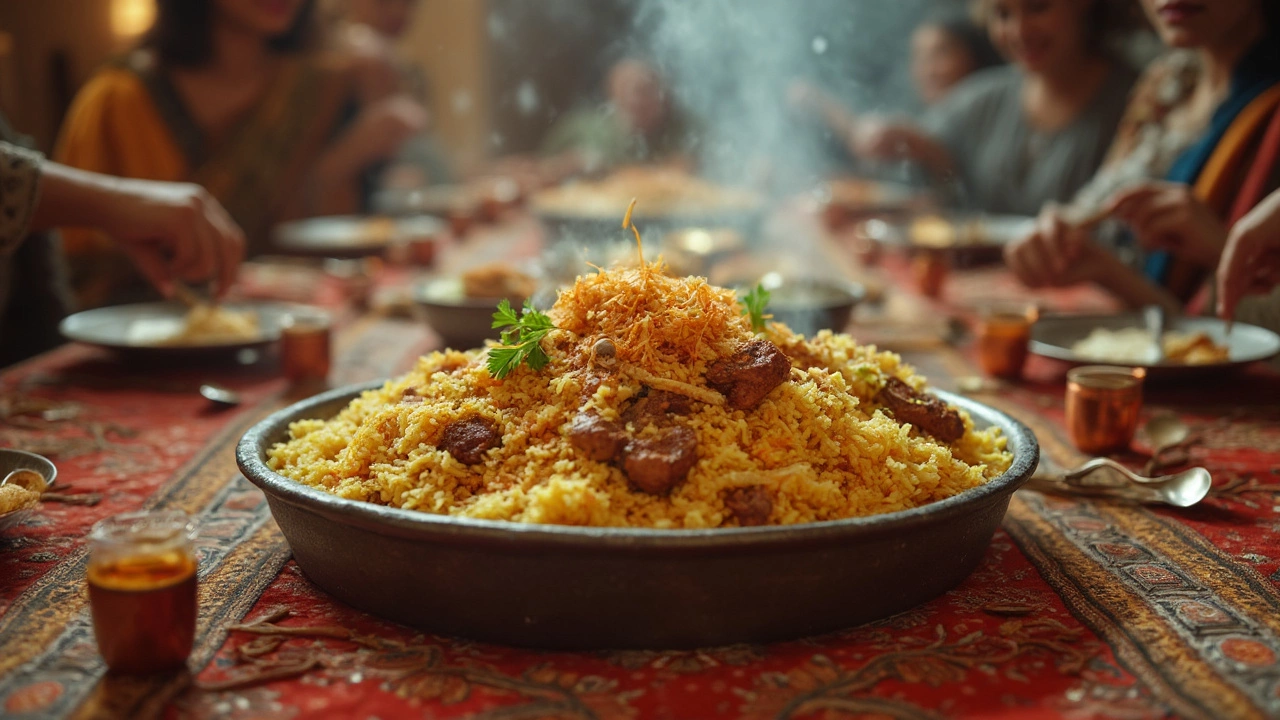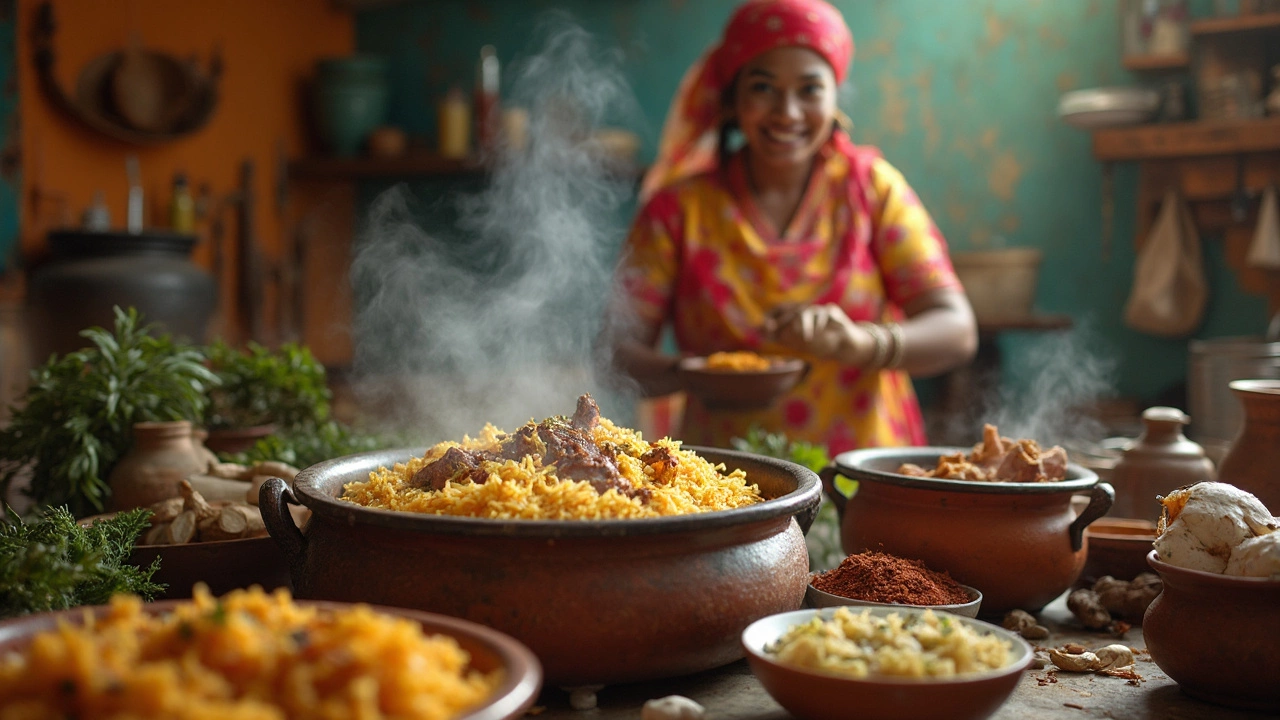Nothing ruins a biryani faster than dry, chewy rice and tough chunks of meat. If you want that restaurant-style juicy biryani, you've got to get the basics right, starting with your marinade. Go big with yogurt—it’s your best friend for breaking down the meat and packing in moisture. Toss in ginger-garlic paste, a squeeze of lemon, and enough spices so the meat isn’t bland. Let the meat chill in the marinade for a few hours at least. Overnight? Even better.
Now, don’t forget about the rice. Most folks rush this part—but a quick soak (about 30 minutes) helps rice cook fast and even, so it stays separate and absorbs juice instead of clumping together. Be careful not to fully cook it before assembling your biryani. Aim for about 70% done—soft on the outside, still a bit firm inside. That way, it’ll finish cooking with all those incredible flavors locked in as it steams with the meat. Getting this right is half the battle for a juicy biryani.
- Choosing the Right Meat and Marinade
- Mastering Rice Soaking and Cooking
- Liquid Ratios and Layering Secrets
- Finishing Moves for Locked-In Juiciness
Choosing the Right Meat and Marinade
If you want juicy biryani, start with the right cut of meat. Bone-in chicken or mutton works best. These cuts stay moist and release flavor as the biryani cooks. Boneless can dry out quickly, so only use it if you’re really in a rush.
The marinade is non-negotiable—don’t skimp or rush this step. Always use thick yogurt as your base. Full-fat yogurt is even better because it makes the meat super soft. Add ginger-garlic paste for that extra punch, plus salt, chili powder, turmeric, and a squeeze of lime juice. Not only does this bring out flavor, but it’s also the real secret behind moist biryani. For chicken, always marinate for at least 2 hours, but longer (up to 8 hours or overnight) makes it even juicier. Mutton needs more time—at least 4 hours, though overnight really works wonders.
Here’s a handy guide for marinating meat for biryani recipe success:
- Chicken (bone-in): 2-8 hours
- Mutton/lamb: 4-12 hours
- Boneless meat: 1-2 hours (watch closely to keep it juicy)
Want to boost the juiciness? Throw in some fried onions and a splash of oil right into your marinade. The onions bring sweetness and extra moisture. If you have access to saffron, steep a pinch in warm milk and use it in the final layering. It adds not only flavor but also a little creaminess to every bite.
For those who like a bit of science, yogurt contains lactic acid—this breaks down tough fibers in meat and helps lock in juices during cooking. Skip yogurt, and you’ll likely end up with dry, tough meat. Here’s a quick stats table for ideal marinating times:
| Meat Type | Best Marinating Time |
|---|---|
| Chicken (bone-in) | 2-8 hours |
| Mutton/Lamb | 4-12 hours |
| Boneless (any) | 1-2 hours |
So, don’t skip, rush, or skimp on marinating your meat. That’s step one for cracking the code to juicy biryani every time.
Mastering Rice Soaking and Cooking
If you want juicy biryani, don’t just dump dry rice into your pot and hope for the best. The real pros swear by soaking their basmati rice—usually for 30 to 45 minutes. This step helps each grain stretch out and get fluffy instead of breaking up or sticking together. As boring as it sounds, it's a game-changer for texture.
“Always soak your rice and never cook it fully before the final dum (steaming). This is the only way to get each grain long, separate, and full of flavor,” says Chef Ranveer Brar, one of India’s go-to biryani experts.
When it comes time to boil, salt the water generously—think pasta water, not drinking water! Add a dash of oil or a few drops of lemon juice; this keeps the rice from clumping. Here’s a quick breakdown:
- Soak rice for 30-45 minutes before boiling.
- Use 7-8 cups of water per cup of rice for boiling, so the grains don’t get crowded.
- Toss a bay leaf or a couple of cloves into the water for extra aroma.
- Don’t fully cook the rice—stop when it’s about 70% done (still firm in the center).
- Drain right away to keep it from getting mushy.
For folks who love numbers, check out this handy cheat sheet for basmati rice boiling:
| Soaking Time | Boiling Water Needed | Cooking Time |
|---|---|---|
| 30 min | 7-8 cups/cup rice | 7-9 min |
| 45 min | Same | 5-7 min |
Stick to these basics and you’ll stop ending up with starchy, soggy rice. Combined with the right marinated meat, you’re halfway to the kind of moist biryani that actually makes people go for seconds.

Liquid Ratios and Layering Secrets
This is where the magic happens—get your liquid ratios and layers spot-on and you’ll never face a dry juicy biryani disaster again. The basic trick: don’t drown your rice or skimp on moisture. For every cup of rice, you’ll need about 1 to 1.25 cups of liquid (that’s counting yogurt, meat juices, and any water or stock you sprinkle in). If you’re using chicken, go with the lower end because it releases more of its own juices. For mutton or beef, you might want to edge closer to 1.25 cups per cup of rice, since they don’t let out quite as much moisture while cooking.
Layering is more than just stacking things up. It’s what lets each bite get that perfect mix of tender meat, fluffy biryani rice, and enough sauce to keep it all juicy. When you start layering, always:
- Begin with a small splash of oil or ghee at the bottom so nothing sticks.
- Spread a layer of marinated meat (and all its marinade) on the base.
- Go in with half your par-cooked rice, then sprinkle 2-3 tablespoons of warm milk (saffron-infused if you want color and smell) across the rice. If you want to amp up flavor, drizzle some stock or even coconut milk here.
- Scatter fried onions, mint, and coriander for a real flavor punch.
- Top with the rest of the rice, repeat the drizzle with milk or stock, and dot a bit more ghee over everything.
Steam is your secret weapon. After layering, seal your pot tightly—foil under the lid, or even some dough around the rim to trap moisture inside. This keeps all the flavors and liquids locked in so your moist biryani isn’t just sitting in sauce—it’s getting bathed in steam that soaks every grain of rice through.
| Meat Type | Liquid (per cup rice) |
|---|---|
| Chicken | 1 cup |
| Mutton/Beef | 1.25 cups |
If you’re ever worried, add a splash of water along the sides of the pot just before you seal it, not on top of the rice. It’ll turn to steam and make everything juicier without making a mushy mess.
Finishing Moves for Locked-In Juiciness
This is where most people miss out on making truly juicy biryani. You can’t just layer and hope for the best—the secret is in the finishing steps that trap moisture and flavor right until you serve.
Start with the dum, or the steam finish. You need a tight seal on your pot so the steam stays inside. If your lid isn’t snug, cover the pot rim with dough or even just a layer of foil. Don’t skip this—it’s what really lets the biryani recipe get that moist, never-dry texture. While on dum, keep the heat super low. This stops the bottom from burning and gives all those juices time to soak into every grain.
Want an extra boost? Add a little milk or a splash of chicken stock with a few drops of rose or kewra water between the layers before sealing. This gives the rice just enough extra moisture and aroma without making things soggy.
- Never stir the biryani right away—rest it for 10-15 minutes after cooking so the steam settles and the flavors lock in.
- Use a flat spatula to serve, digging gently from the sides so you don’t break or mash the rice.
- For added moist biryani, garnish with fried onions or a handful of fresh herbs for extra layers of taste and moisture.
Here's what the difference looks like in numbers:
| Method | Average Moisture Retention (%) |
|---|---|
| No dum seal | 55 |
| Tight dum/steam finish | 85 |
That tight seal boosts your biryani moisture by a lot. Stick with these finishing tricks and your biryani won't just be full of flavor—it’ll be juicy right down to the last grain.
